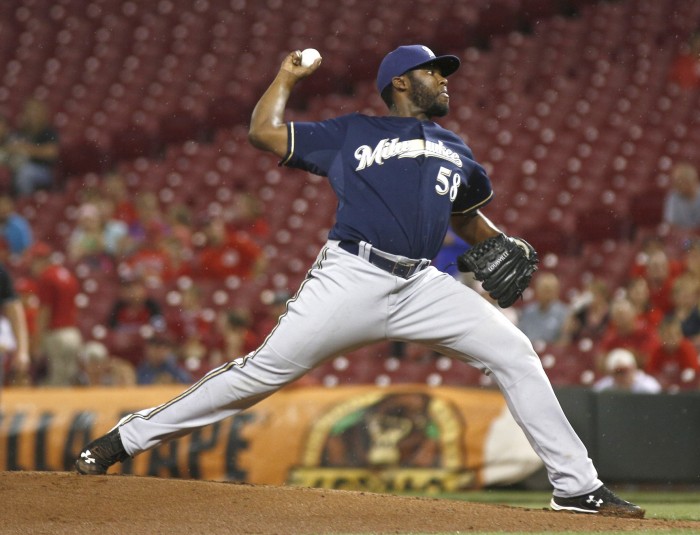We haven’t written much on this site about Ariel Pena, and that is generally for good reason. He is a 26-year-old right-handed pitcher who isn’t a top prospect or a particularly impressive minor-league performer. The Brewers’ major-league rotation, while not stuffed with great options, is generally full of pitchers who are higher in the pecking order than Pena, whether that be because of contract status (Matt Garza) or youth and potential (virtually everyone else).
Pena, though, appears near the top of a very interesting leaderboard. Of all starting pitchers who threw at least 200 pitches in 2015, Pena ranks fifth in whiffs per swing. He induced more misses than such luminaries as Jose Fernandez, Jacob DeGrom, and Madison Bumgarner (among others). Somehow, the only pitchers with better whiff rates than Pena were Francisco Liriano, Clayton Kershaw, Chris Sale, and Max Scherzer.
This obviously is not to suggest that Pena is a huge breakout candidate; he’s always struck out a decent number of people, and his actual strikeout rate in the majors in 2015 was not absurdly high. In fact, at 8.9 per nine innings, it was right in line with his minor league averages. This, then, presents a puzzle: How does one get that many swings-and-misses and not post an elite strikeout rate?
An obvious possible answer (and definite truth) is that Pena has no idea where the ball is going. His minor-league walk rates (and 4.6 walks per nine in the big leagues last year) certainly indicate that he can’t throw strikes consistently, but that is not really a surprise. Minor League Baseball is littered with hard-throwing righties who couldn’t hit the broad side of a barn; most of those, however, don’t show up at the top of a whiff-rate leaderboard.
A second contributing factor is that this whiff rate may be mere variation and not truly representative of a specific talent that he has. However, without further data from minor-league parks (which does not exist), we have no way of directly proving or disproving this. I will therefore continue with tempered expectations, although it is worth noting that such a single-season whiff rate is spectacular even were it to eventually prove to be an outlier.
Francisco Liriano provides an interesting contrast. As he is an actual good major-league pitcher, there may not be any insight we can (or should) glean from a comparison of the two. However, Liriano’s walk rate makes him an interesting foil for Pena. Liriano appears at the top of the aforementioned whiff-rate leaderboard, but he also walks a ton of batters. He has obviously been a lot more successful than has Pena, but some of their characteristics are the same.
Similarly to Liriano, Pena doesn’t have good command of the strike zone but gets a ton of swings-and-misses. Unlike Liriano, though, Pena has had very little major-league success.
A quick glance at Pena’s pitch usage explains why. Where Liriano frequently shows off his changeup, Pena does not really have one. In his short big-league stint in 2015, he threw his changeup just over five percent of the time. Liriano, meanwhile, has thrown his nearly twenty percent of the time over the course of his career.
In many ways, none of this is that surprising. We all mostly knew that Pena was a hard thrower who had some good qualities but more bad ones. He appears destined for the middle of a bullpen somewhere, although his whiff rate could very well prove more important in one-inning stints than it has in longer outings and push him towards the end of games. Ultimately, if he ends up as a set-up man or closer (whether it be in Milwaukee or elsewhere), the inevitably low cost it would have taken to acquire him will make him a good value.
Maybe that is the lesson here, though. Pena is a mediocre starter with (apparently) one incredible skill. His lack of a changeup and subsequent inability to properly sequence his pitches has mostly mitigated his whiff rate. However, we have seen many average-at-best starters move to the bullpen and see immediate, relatively unexplainable success. Perhaps this is a key to Pena’s future: As a reliever, his lack of a changeup is less of an impediment to success. With less of a need to worry about sequencing, his whiff rate could spike, leading to a rise in strikeout rate and, ultimately, success.
That is obviously a bit of optimism and a look at his best-case scenario. However, the fact that his whiff rate ranked fifth among all starters is truly incredible, and it is worth taking note of. Seeing him figure out how to properly utilize such a skill were he to be moved to the bullpen would not be too much of a shock.

Interesting that he started in the bullpen last year, was getting beat up, moved to rotation, and then had a lot more success.